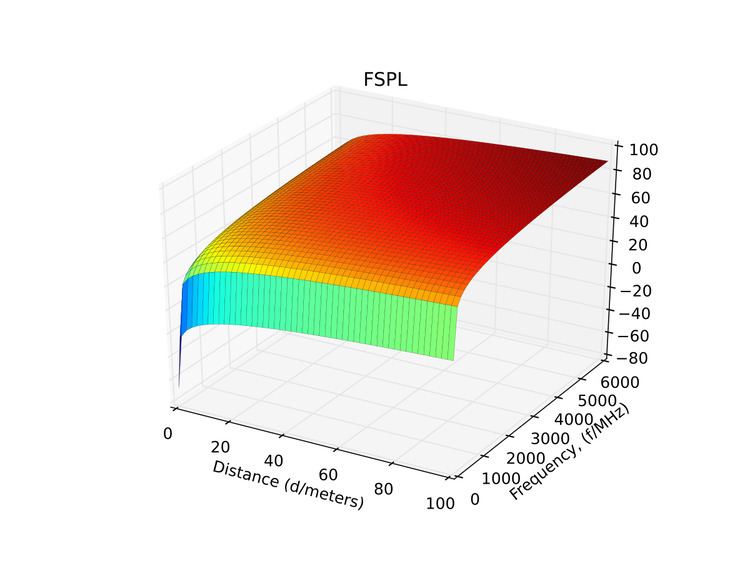 | ||
In telecommunication, free-space path loss (FSPL) is the loss in signal strength of an electromagnetic wave that would result from a line-of-sight path through free space (usually air), with no obstacles nearby to cause reflection or diffraction. It is defined in "Standard Definitions of Terms for Antennas", IEEE Std 145-1983, as "The loss between two isotropic radiators in free space, expressed as a power ratio." Usually it is expressed in dB, although the IEEE standard does not say that. So it assumes that the antenna gain is a power ratio of 1.0, or 0 dB. It does not include any loss associated with hardware imperfections, or the effects of any antenna gains. A discussion of these losses may be found in the article on link budget. The FSPL is rarely used standalone, but rather as a part of the Friis transmission equation, which includes the gain of antennas.
Contents
Free-space path loss formula
Free-space path loss is proportional to the square of the distance between the transmitter and receiver, and also proportional to the square of the frequency of the radio signal.
The equation for FSPL is
where:
This equation is only accurate in the far field where spherical spreading can be assumed; it does not hold close to the transmitter.
Free-space path loss in decibels
A convenient way to express FSPL is in terms of dB:
where the units are as before.
For typical radio applications, it is common to find
For
For
For
Physical explanation
The FSPL expression above often leads to the erroneous belief that free space attenuates an electromagnetic wave according to its frequency. This is not the case, as there is no physical mechanism that could cause this. The expression for FSPL actually encapsulates two effects.
Distance dependency
Dependency of the FSPL on distance is caused by the spreading out of electromagnetic energy in free space and is described by the inverse square law, i.e.
where:
Note that this is not a frequency-dependent effect.
Frequency dependency
The frequency dependency is somewhat more confusing. The question is often asked: Why should path loss, which is just a geometric inverse-square loss, be a function of frequency? The answer is that path loss is defined on the use of an isotropic receiving antenna (
Hence path loss is a convenient tool; it represents a hypothetical received-power loss that would occur if the receiving antenna were isotropic. Therefore, the FSPL can be viewed as a convenient collection of terms that have been assigned the unfortunate name path loss. This name calls up an image of purely geometric effect and fails to emphasize the requirement that
Dependency of antenna aperture from antenna gain is described by the formula:
This formula represents a well-known fact, that the lower the frequency (the longer the wavelength), the bigger antenna is needed to achieve certain antenna gain. Therefore, for a theoretical isotropic antenna (
where
In simple terms the frequency dependency of the path loss can be explained like this: with the increase of the frequency the requirement to keep the gain of the receiving antenna intact will cause an antenna aperture to be decreased, which will result in less energy being captured with the smaller antenna, which is similar to increasing the path loss in the situation when receiving antenna gain would not have been fixed.
